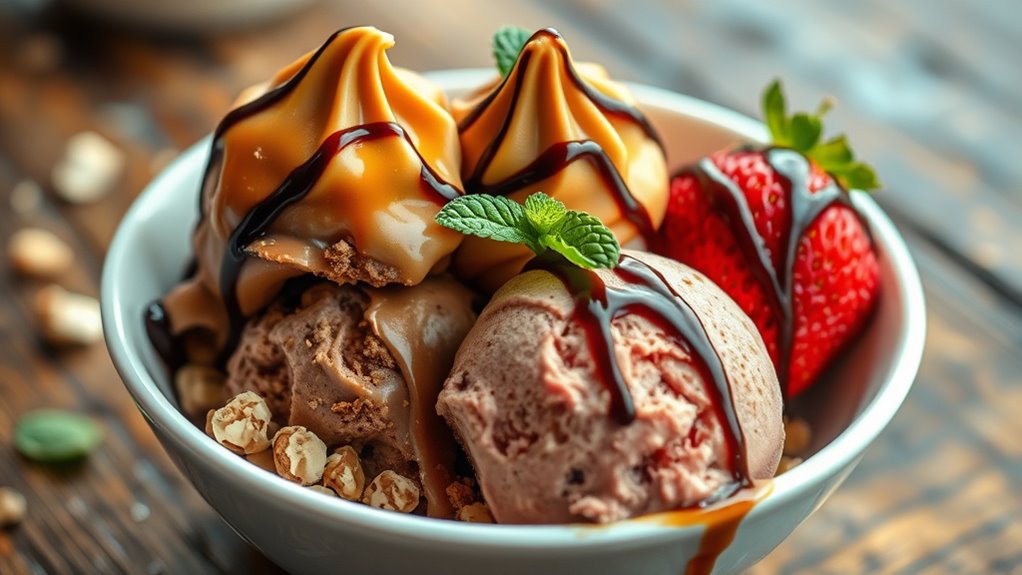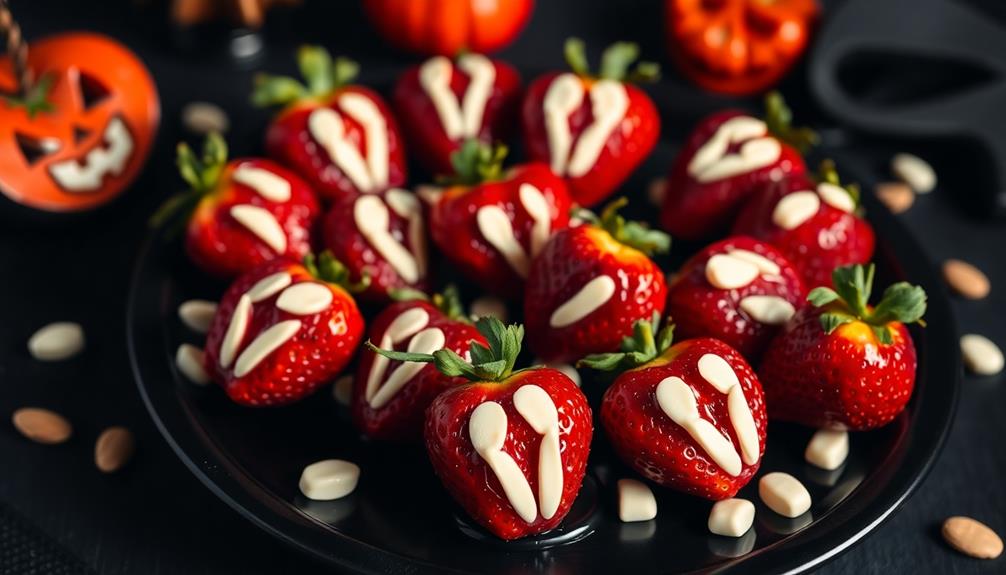To make homemade ice cream truly impressive, start with high-quality ingredients like fresh cream, real butter, and pure vanilla to boost flavor. Chill your base thoroughly and pre-freeze the bowl for ideal texture. Incorporate stabilizers to keep it smooth and experiment with flavor combinations and mix-ins. Master your churning technique, avoid overfilling, and store properly to prevent ice crystals. Add a splash of alcohol for softness, and finish with creative garnishes—discover how to elevate your ice cream even further.
Key Takeaways
- Use high-quality ingredients like fresh cream, real butter, and pure vanilla for richer, more authentic flavor.
- Chill your ice cream base thoroughly and pre-freeze the bowl for smoother, creamier results.
- Incorporate stabilizers and sweeteners carefully to achieve a velvety texture and optimal flavor balance.
- Add mix-ins during churning for even distribution and a more impressive, flavorful experience.
- Present your ice cream with attractive toppings and thoughtful plating to elevate its visual appeal.
Use High-Quality Ingredients for Richer Flavor

Using high-quality ingredients is the easiest way to guarantee your homemade ice cream tastes rich and flavorful. Start with premium ingredients like fresh cream, real butter, and pure vanilla extract to elevate every bite. Incorporate seasonal produce—such as ripe berries, juicy peaches, or fragrant herbs—to add vibrant flavors and natural sweetness. These ingredients not only enhance the taste but also improve the texture, making your ice cream irresistibly creamy. Skip artificial flavorings and processed additives, which can dull the overall experience. Investing in quality ingredients may cost a bit more upfront, but the difference in taste is well worth it. Remember, the key to impressive homemade ice cream is selecting the freshest, highest-quality ingredients available, especially those that are in season. Additionally, choosing ingredients with essential nutrients and antioxidants can further boost the health benefits of your treat. Using fresh, seasonal ingredients can also help you create unique flavor combinations that impress your friends and family.
Chill Your Base Thoroughly Before Freezing

Once you’ve selected your high-quality ingredients, the next step is to guarantee your ice cream base is thoroughly chilled before freezing. To do this, you should chill your base for at least four hours, or overnight if possible. This ensures the mixture is cold enough for ideal texture and prevents ice crystals from forming. Additionally, pre freeze your bowl in advance—ideally for 24 hours—so it’s icy and ready to keep your ice cream smooth. When you combine a well-chilled base with a pre-frozen bowl, you’ll achieve a creamier, more consistent ice cream. Using the right freezing techniques is essential for professional-quality results that will impress your friends and elevate your homemade ice cream game. Regularly checking your air quality indicators can help you determine the best times to operate your appliances for optimal freshness and health benefits. Proper temperature control during freezing also plays a vital role in achieving the perfect texture. Furthermore, understanding the chilling process can help you optimize your setup for the best possible outcome. Ensuring your environment has optimal food safety conditions can also prevent contamination and spoilage during the process.
Incorporate Stabilizers or Additives for Creamier Texture

Incorporating stabilizers or additives can substantially improve the texture of your homemade ice cream, making it creamier and less prone to ice crystal formation. Stabilizer types, such as gelatin, guar gum, or cornstarch, help thicken and stabilize the mixture, resulting in a smoother finish. Additive benefits include enhanced creaminess, better scoopability, and extended shelf life. Using these ingredients in small amounts guarantees a rich texture without overpowering flavor. For example, a teaspoon of gelatin dissolved in warm water can work wonders, or a half teaspoon of guar gum added during mixing boosts creaminess. Incorporating texture enhancement techniques can further refine the mouthfeel of your ice cream, ensuring a velvety consistency. By integrating stabilizers or additives thoughtfully, you’ll achieve a professional-quality ice cream that’s irresistibly smooth and luxurious every time. Additionally, understanding the financial impact of entertainment industries can provide insights into how popular products and media influence consumer trends and preferences. Incorporating scientific research on texture enhancement can further optimize your recipe for a perfect, velvety finish. Moreover, exploring state-specific tax laws can help you plan your investments and savings strategies more effectively. Maximizing space and organization in your kitchen can also make the process of preparing and experimenting with recipes more efficient and enjoyable.
Experiment With Flavor Combinations and Mix-Ins

Mixing up flavor combinations and adding mix-ins can turn your homemade ice cream into a personalized masterpiece. Start by exploring flavor pairings that complement each other, like chocolate and caramel or berry and lemon. Don’t be afraid to get creative—think beyond traditional flavors and try pairing salty with sweet or tart with smooth. For mix-in ideas, consider chopped cookies, nuts, swirls of fruit preserves, or candy pieces. Adding these during the churning process guarantees even distribution and bursts of flavor in every bite. Remember, balancing bold flavors with milder ones creates harmony. Keep experimenting with different combinations until you find your favorites. The more you try, the more unique and delicious your homemade ice cream will become, impressing friends with your inventive twists.
Master the Art of Proper Churning Technique

To get perfectly creamy ice cream, you need to master your churning technique. Keep the temperature consistent so it freezes evenly, and adjust your mixing speed to avoid over- or under-whipping. Be gentle when incorporating air to guarantee a smooth, fluffy texture. Additionally, understanding industry trends can help you choose the best equipment and techniques for optimal results. Monitoring AI advancements can also provide innovative solutions for perfect consistency and flavor in homemade ice cream. Staying informed about automation in business can inspire new methods to streamline your process and improve efficiency. Incorporating skincare ingredients like glycolic acid in your routine can also help maintain healthy skin after frequent handling and exposure during ice cream making.
Maintain Consistent Temperature
Maintaining a consistent temperature during churning is essential for achieving smooth, creamy ice cream. Proper temperature control ensures the mixture freezes evenly, preventing large ice crystals from forming. To do this, keep your ice cream maker at the right setting and avoid sudden temperature fluctuations. Consistency maintenance is key—if the mixture gets too warm, it won’t freeze properly, resulting in a grainy texture. Chill your ingredients thoroughly before starting, and monitor your freezer’s temperature if possible. Using a pre-cooled bowl or ensuring the machine’s interior is cold helps uphold the ideal environment. Staying attentive to temperature changes allows you to produce ice cream with that perfect, velvety consistency that will impress your friends. Additionally, understanding RMDs and how they impact your retirement savings can help you plan for financial stability in the future. Proper temperature regulation in your ice cream maker is essential for achieving the desired texture and quality.
Use Proper Mixing Speed
Mastering the proper mixing speed is essential for achieving creamy, evenly textured ice cream. If you set the mixing speed too high, you risk over-blending, which can lead to a grainy or icy texture. Conversely, too slow a speed may result in uneven blending, leaving streaks or inconsistent mixing. Find the right balance by following your ice cream maker’s instructions and adjusting the speed gradually. During churning, aim for a steady, moderate pace that promotes a smooth blending consistency. This controlled speed helps incorporate ingredients uniformly and develops the desired creamy texture. Keep an eye on your mixture and avoid abrupt changes, ensuring your ice cream churns evenly without compromising quality or texture. Proper mixing speed is key to professional-quality homemade ice cream every time. Additionally, understanding the best ice cream makers can help you optimize your churning process for the best results. Developing a consistent technique also involves cultivating attention during the process, which enhances the overall quality of your ice cream. Incorporating tuning techniques from automotive expertise can serve as a helpful analogy for maintaining the right balance and control during churning. Being mindful of the mixing speed can prevent common issues like ice crystal formation and ensure a smooth, luxurious final product. Paying close attention to ingredient ratios is also crucial for achieving the perfect flavor and texture balance.
Incorporate Air Carefully
Incorporating air into your ice cream mixture during churning is essential for achieving a light, fluffy texture. Proper air incorporation creates foam stability, preventing ice cream from becoming dense or icy. To do this effectively, start the churning process at a moderate speed and avoid overmixing, which can deflate the foam. Keep an eye on the texture; you want a soft, airy consistency before freezing. Using the right technique ensures your ice cream has a smooth mouthfeel and impressive volume. Additionally, understanding the churning process can help you better control the amount of air incorporated into your ice cream.
Adjust Sweetness and Sweetener Types to Your Taste

Adjusting the sweetness of your ice cream is key to achieving the perfect flavor. To do this, focus on sweetness balancing—adding just enough sugar to enhance the ingredients without overpowering them. Taste your base before freezing; you can always add more sweetener later, but you can’t take it out. If you want to reduce refined sugar, try alternative sweeteners like honey, maple syrup, or agave nectar. These options not only sweeten your ice cream but also add unique flavors. Keep in mind that some sweeteners may affect texture or freezing point, so experiment to find what works best for your recipe. Adjusting sweetness to your taste ensures a delicious, personalized treat that everyone will love.
Avoid Overfilling Your Ice Cream Maker

To guarantee your ice cream churns smoothly and freezes evenly, it’s essential not to overfill your ice cream maker. Overfilling can cause uneven freezing and strain your machine, especially when using different ice cream maker models. To prevent issues, fill the bowl only up to the recommended level, usually about two-thirds full. If you’re troubleshooting common issues like inconsistent texture or motor failure, remember that overfilling is often the culprit. Here’s a quick guide:
| Ice Cream Maker Model | Maximum Fill Level | Troubleshooting Tips |
|---|---|---|
| Countertop | 2/3 full | Avoid overloading to prevent strain |
| Frozen bowl | 2/3 full | Check for proper freezing before use |
| Compressor-based | 3/4 full | Ensure correct capacity |
Stay within these limits for perfect, smooth results.
Freeze and Store Properly to Prevent Ice Crystals

Properly freezing and storing your homemade ice cream is essential to prevent the formation of ice crystals, which can ruin its smooth texture. To do this, guarantee your ice cream is airtight, using a tight-fitting lid or plastic wrap directly on the surface to minimize air exposure. This helps prevent freezer burn, which can cause ice crystals and a dull flavor. Store your ice cream in the coldest part of the freezer, ideally at or below 0°F (-18°C). Avoid frequent temperature changes by keeping the container sealed tightly when not in use. Proper storage not only prevents ice crystal formation but also preserves creamy consistency and flavor, making sure your ice cream stays fresh and delicious until you’re ready to enjoy it.
Add Alcohol or Other Liquids for Softer Texture

Adding alcohol or other liquids to your homemade ice cream can help achieve a softer, scoopable texture straight from the freezer. Alcohol infusion is a simple way to make your ice cream less icy and easier to serve. When making liquid adjustments, consider using spirits like vodka, rum, or liqueurs, which have a high alcohol content and won’t freeze solid. Keep in mind that too much alcohol can prevent the ice cream from setting properly, so add small amounts gradually—about 1-2 tablespoons per quart of base. You can also experiment with fruit juices or flavored syrups to enhance both flavor and texture. Remember, the goal is to balance liquid adjustments to maintain a creamy consistency without compromising the ice cream’s structure.
Garnish and Serve Creatively for a Professional Finish

To make your homemade ice cream truly stand out, focus on artistic presentation techniques that catch the eye. Try unique garnish ideas like fresh herbs, edible flowers, or drizzles of sauce to add flair. Finish with elegant serving tips, such as stylish bowls or layered scoops, to impress every guest.
Artistic Presentation Techniques
Elevating your ice cream presentation can make your homemade treats look as professional as store-bought. Start by adding colorful sprinkles to the top of your scoops for a fun, eye-catching touch. They create a vibrant contrast and make each serving pop. For a more elegant look, incorporate edible flowers like violets or pansies, which add a delicate, sophisticated flair. Use a warm spoon to shape your ice cream into neat scoops or creative shapes before adding toppings. Consider serving in stylish bowls or cones, and garnish with fresh mint leaves for a pop of green. Thoughtful placement of sprinkles and edible flowers transforms simple ice cream into a visually stunning dessert that’s sure to impress.
Unique Garnish Ideas
For a truly professional touch, think beyond traditional toppings and experiment with unexpected garnishes that complement your ice cream’s flavor. Fruit toppings, like fresh berries, sliced kiwi, or citrus zest, add vibrant color and a burst of freshness that elevates the overall presentation. Edible flowers, such as pansies or violets, bring an elegant, delicate aesthetic that impresses and delights. Combine these elements thoughtfully—pair bright berries with a scoop of vanilla or sprinkle edible flowers over chocolate for a striking contrast. These unique garnishes not only enhance visual appeal but also add complementary flavors and textures. With a little creativity, your ice cream will look as sophisticated as it tastes, making every serving feel like a professional masterpiece.
Elegant Serving Tips
Creating an elegant presentation can turn an ordinary scoop into a memorable dessert. Start with decorative plating by choosing your favorite dishes or stylish bowls that complement your ice cream’s colors. Use fresh herbs, edible flowers, or a drizzle of caramel or fruit coulis to add visual appeal. Carefully arrange your scoops for a polished look, perhaps stacking or shaping them into neat spheres. Pair your ice cream with complementary beverages like sparkling wine, coffee, or flavored liqueurs to elevate the experience. Serving with a refined touch not only impresses your guests but also enhances flavors, making your homemade ice cream feel truly professional. A thoughtful presentation transforms a simple treat into a sophisticated dessert everyone will admire.
Frequently Asked Questions
Can I Make Dairy-Free Ice Cream at Home?
Yes, you can make dairy-free ice cream at home. Just choose dairy substitute options like coconut milk, almond milk, or cashew cream, which work great as bases. You can follow vegan ice cream recipes that use these substitutes, adding flavors and sweeteners to suit your taste. With a little effort, you’ll create creamy, delicious dairy-free ice cream that rivals traditional versions and impresses everyone.
What Are the Best Alternatives to Sugar for Sweetness?
Looking for the best alternatives to sugar for sweetness? You can try natural sweeteners like honey, maple syrup, or agave nectar, which add flavor and sweetness naturally. Sugar substitutes like stevia or erythritol are also great options—they’re low-calorie and won’t spike your blood sugar. Experiment with these options to find the perfect balance for your homemade ice cream, making it both delicious and healthier!
How Long Should I Churn Homemade Ice Cream?
When you’re churning homemade ice cream, aim for a churn time of about 20-25 minutes, depending on your machine. For example, if you churn longer, say 30 minutes, your ice cream might become too firm. Once finished, freeze it for at least 4 hours to achieve the perfect scoop consistency. Keep an eye on the texture during churn time and adjust freezing duration for creamy, scoopable results.
Is It Necessary to Use an Ice Cream Maker?
You don’t need an ice cream maker to make delicious homemade ice cream. You can achieve creamy texture by mixing your ingredients well and freezing the mixture, stirring every 30 minutes to prevent ice crystals. Get creative with DIY toppings like fresh fruit or chocolate chips, and follow storing tips to keep your ice cream fresh. With patience and a little effort, your homemade ice cream will impress everyone without special equipment.
How Can I Prevent Ice Crystals During Storage?
Think of your ice cream as a treasure chest; you want it smooth and inviting, not icy. To prevent ice crystals during storage, use proper storage tips like airtight containers and regular stirring. Wrap the surface with plastic wrap before sealing to minimize air exposure. These ice crystal prevention tricks keep your homemade ice cream creamy and delicious, ensuring each scoop is a delightful treat rather than a frosty surprise.
Conclusion
Think of making ice cream like painting a masterpiece—you need the right tools, patience, and a splash of creativity. When I first tried homemade vanilla, I was amazed it tasted better than store-bought, like discovering a hidden gem. With these tips, you’ll craft treats so delicious, your friends will think you bought them from a fancy shop. Embrace the process, experiment freely, and enjoy every sweet, creamy moment.










